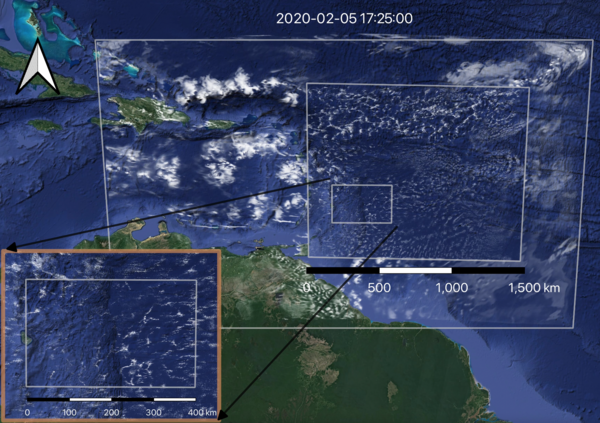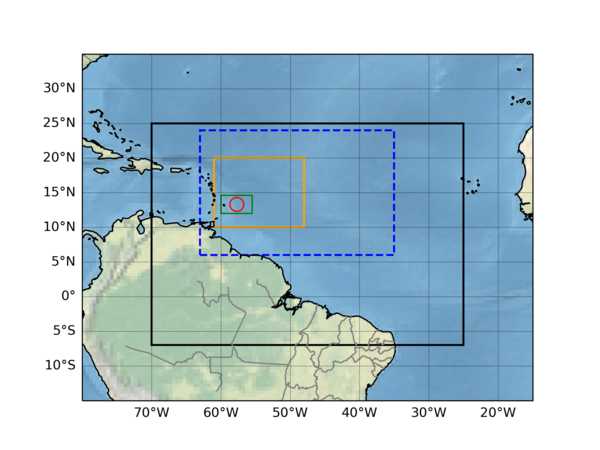EUREC4A Model Intercomparison Project

Fig. 1 Top view of the Liquid Water Path of a Large Eddy simulation (within yellow box) at 100 meter resolution and of a Storm Resolving Simulation ( outside yellow box) at 2,5 km resolution.
Introduction
Shallow Cumulus over the subtropical oceans is the most abundant cloud type in our climate system and its radiative response to global warming is highly uncertain. Previous MIPs on shallow cumulus convection have primarily explored the representation of spatially unorganised shallow cumulus convection and their response to climate warming.
It has become clear however over the last decade that marine shallow cumulus convection has a natural strong tendency to develop into mesoscale organised cloud structures and that unorganised shallow cumulus convection is the exception rather than the rule.
It is particular challenging to realistically simulate these mesoscale cloud patterns. On the one hand, this requires turbulence resolving resolutions to represent the small-scale vertical convective mixing processes while at the same time domains of several hundreds of kilometres are needed to represent the observed mesoscale cloud structures. It is only recently that the computational capability is allowing us to simulate these rich structures.
It is for this reason that we propose a MIP on shallow cumulus convection over the Northern Atlantic subtropical ocean such as observed during the EUREC4A field campaign in January-February 2020.
The main objectives of this MIP are:
- Assessing the simulation capability of the observed shallow cloud mesoscale organisation over the subtropical ocean.
- Understanding the underlying dynamical processes that lead to these mesoscale cloud patterns
- Assessing the radiative response of this abundant cloud regime to climate warming using the Pseudo-Global Warming(PGW) framework
Ideally this requires models that simulate the atmosphere at turbulent resolving resolutions of 100 meter on domains of several thousands of kilometres. At present this is not yet a numerically feasible option. We therefore propose two different model approaches in this MIP that concentrate on different spatio-temporal domains and resolution:
- Storm Resolving Model (SRM) simulations with resolutions in the range of 0.5~2.5 km over a domain of preferably 3000 x 4000 km2 for the whole EUREC4A period of Jan-Feb 2020.
- Large Eddy Model (LEM) simulations with resolutions in the range of 50~250 meter over a domain of 500 x 300 km for the period Februari 1-11 2020.
The simulations will be carried for under present day conditions such as observed during the EUREC4A field campaign and additionally for future weather conditions by using a Pseudo Global Warming perturbation. For the latter we propose to do a +4K SST AMIP run in which the perturbed lateral boundary conditions will be provided from climate models with a medium (GFDL) climate sensitivity.
Future weather simulations using pseudo-global warming perturbations can only be done when open lateral boundary conditions are used. In case of SRM's we prepared hourly ERA5 fields that can be used as initial and boundary fields as well as hourly perturbed ERA5 fields that can be used for the future weather simulations. In case of LEM's we prepared hourly fields from the mesosscale model COSMO that can be used as initial and boundary fields as well as perturbed COSMO fields that can be used for the future weather runs. Dependent on whether you use a SRM or a LEM please proceed
- HERE for the set up of Storm Resolving Models for present day and future weather EUREC4A simulations
- HERE for the set up of Large Eddy Models that use open boundary conditions for present day and future weather EUREC4A simulations.
In case you want to participate with a Large Eddy Model that can only work with lateral periodic boundary conditions it is not possible to do future weather EUREC4A simulations within the pseudo-global warming framework. It is however possible to participate for the present day EUREC4A runs for which we made hourly large-scale dynamical tendencies available from the mesoscale model AROME-HARMONIE that can be used to force the LEM. So in that case please proceed
- HERE for the set up of Large Eddy Models that use periodic boundary conditions for present day EUREC4A simulations.

Fig. 2. Preferred Storm-Resolving Model domain (Black Box), Typical used Storm Resolving Model domain (Blue Box) and Large Eddy Model domain (Green Box). The orange box indicates the common domain of analysis for the Storm-Resolving Models
